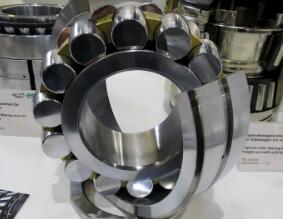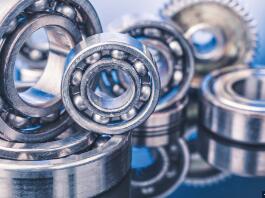Spherical roller bearings 101:How to Choose the Best Spherical Roller Bearings for Your Application
Learn everything you need to know about spherical roller bearings, including the different types, components, advantages, and typical applications.
Discover how to choose the best spherical roller bearings for your specific application to improve performance and prolong service life.
Spherical roller bearings are crucial components in heavy machinery, but choosing the right type for your application can be overwhelming.
This article breaks down the key features of spherical roller bearings, including types, components, advantages, and common applications.
Discover how to optimize performance and prolong service life with the right choice.
Choose the best spherical roller bearing by understanding types, evaluating components, and considering advantages & common applications.
Select from reputable manufacturers for optimal performance and longevity of your machinery
With our in-depth knowledge and expert analysis, you'll gain a deeper understanding of these critical components and how to choose the right one for your machinery.
This guide is your go-to resource for maximizing performance and prolonging the service life of your equipment.

Define spherical roller bearings
Spherical roller bearings are a rolling-element bearing used to support rotating shafts in applications that may experience misalignment or shaft deflections.
These bearings can handle heavy radial and axial loads and are characterized by their ability to accommodate misalignment.
This is achieved by their unique internal design, which includes a spherical shape on the outer ring and spherical rollers.
This design allows for a small degree of angular misalignment, which can occur due to manufacturing tolerances, installation errors, or other factors.
Additionally, because the rollers are cylindrical with a slightly over-inflated (barrel-like) profile, they can distribute the load evenly across the bearing, reducing the chances of failure.
SKF invented spherical roller bearings in 1919, offering the industry's most comprehensive range of spherical roller bearings.
Their selection of spherical roller bearings is designed for various applications, including wind turbine main shafts, continuous casters, vibratory applications, and high-speed applications.
They also offer different solutions, such as bearings with Solid Oil, split bearings, SKF ConCentra roller bearing units, and bearings with a three-barrier solution which are the harshest operating environments.
Spherical roller bearings are a reliable and efficient solution for applications that may experience heavy loads and misalignment.
Their unique design allows them to handle these conditions while minimizing maintenance costs and prolonging bearing service life.
Types of Spherical Roller Bearings
1. Open spherical roller bearings:
Open spherical roller bearings are a type of spherical roller bearings with no seals or shields to protect the bearing from external contaminants, such as dirt, dust, and moisture.
Instead, the bearing is open on both sides, allowing for the free flow of lubricant and the easy detection of any damage or wear.
These bearings are suitable for applications where contamination is not a significant concern and where the bearing can be easily lubricated.
They also can be suitable for high-temperature applications.
One of the main benefits of open spherical roller bearings is that they are relatively low-cost and easy to install.
They also require less maintenance than sealed or shielded bearings.
However, they are not as well-suited for environments where contamination is a significant concern.
They can be more sensitive to dust and debris or too high or low temperatures, reducing the bearing's life.
2. Sealed spherical roller bearings:
Sealed spherical roller bearings are a type of spherical roller bearings that have seals or shields on both sides of the bearing to protect it from external contaminants, such as dirt, dust, and moisture.
The seals prevent the ingress of contaminants, which can extend the life of the bearing by reducing the need for maintenance and by reducing the chances of damage or wear.
One of the main benefits of sealed spherical roller bearings is that they are well-suited for environments where contamination is a significant concern.
They are also less susceptible to damage from exposure to high temperatures and humidity, which can extend the life of the bearing.
However, sealed spherical roller bearings are generally more expensive than open spherical roller bearings and can be more difficult to install.
3. Double-row spherical roller bearings:
Double-row spherical roller bearings are a type of spherical roller bearings that have two rows of spherical rollers, which are arranged in a concave raceway in the outer ring and a convex raceway in the inner ring.
This double-row design allows for a higher load-carrying capacity than single-row spherical roller bearings.
Double-row spherical roller bearings can be opened or sealed, depending on the application.
Double-row spherical roller bearings are suitable for applications that require heavy loads, such as wind turbines, cranes, and other heavy machinery.
Due to the double row of rollers, they have higher load-carrying capacity and durability than single-row spherical roller bearings.
However, they are also more expensive than single-row spherical roller bearings and can be more challenging to install.
All three types of spherical roller bearings have different advantages and disadvantages.
The choice of which type to use will depend on the specific application and the environment in which the bearing will be used.
Open spherical roller bearings are best for low-contamination environments and easy lubrication, sealed spherical roller bearings are best for high-contamination environments,
extra protection from external elements and double-row spherical roller bearings are best for high-load carrying applications.
Components of a Spherical Roller Bearing

1. Inner ring:
The inner ring, also known as the "bore" or "inner race," is the component of the spherical roller bearing that is located on the shaft.
It is typically made of hardened steel and serves as the guide and support for the rollers.
The inner ring also has a cylindrical bore to accommodate the shaft, and it can have a spherical surface on the outer side that corresponds with the outer ring to provide misalignment capabilities
One of the main functions of the inner ring is to provide a precise and smooth surface for the rollers to rotate on, which reduces friction and extends the life of the bearing.
Additionally, the inner ring provides an exact fit for the shaft, which helps to prevent slippage and improves the bearing's performance.
The inner ring also helps to transmit the load from the outer ring to the shaft, which is an important factor in the overall load-carrying capacity of the bearing.
2. Outer ring:
The outer ring, also known as the "housing" or "outer race," is the component of the spherical roller bearing that is located in the housing.
It is typically made of hardened steel and serves as the guide and support for the rollers.
The outer ring has a spherical surface on the inner side that corresponds with the inner ring to provide misalignment capabilities.
The main function of the outer ring is to provide a precise and smooth surface for the rollers to rotate on, which reduces friction and extends the life of the bearing.
Additionally, the outer ring helps to distribute the load evenly across the rollers, which reduces the chances of failure.
The outer ring also helps to transmit the load from the shaft to the housing, which is an important factor in the overall load-carrying capacity of the bearing.
3. Rollers:
The rollers, also known as the "elements" or "balls," are the cylindrical components of the spherical roller bearing located between the inner and outer rings.
They are typically made of steel and have a slightly over-inflated (barrel-like) profile.
They are responsible for transmitting the load from one ring to the other and providing the rolling motion that makes the bearing so efficient.
Rollers distribute the load evenly across the bearing, reducing the chances of failure.
They are also designed to rotate with minimal friction and maximum efficiency.
This is achieved through precision manufacturing and materials, which ensure that the rollers are perfectly round and have a smooth surface finish.
The rollers can handle high loads and misalignments due to their unique cylindrical shape and over-inflated profile.
4. Cage:
The cage, also known as the "separator" or "retainer," is the component of the spherical roller bearing that holds the rollers in place.
It is typically made of lightweight and durable materials, such as steel or polyamide.
The main function of the cage is to keep the rollers evenly spaced and properly aligned, which reduces friction and improves the bearing's performance.
It also prevents the rollers from colliding with each other or with the inner or outer rings, which can cause damage or reduce the life of the bearing.
The cage also helps to reduce the overall weight of the bearing, which can be important in high-speed or high-load applications.
The cage also guides the rollers in a proper position during the rotation, which ensures they can transmit the load effectively.
Advantages of Spherical Roller Bearings

1. Minimize friction:
One of the main advantages of spherical roller bearings is that they minimize friction during operation.
This is achieved by the unique design of the bearing, which includes a spherical shape on the outer ring and spherical rollers.
The spherical shape of the outer ring allows for a small degree of angular misalignment, which can occur due to manufacturing tolerances, installation errors, or other factors.
Additionally, because the rollers are cylindrical with a slightly over-inflated (barrel-like) profile, they can distribute the load evenly across the bearing, reducing the chances of failure.
The rollers, which are the elements of the bearing that transmit the load and provide the rolling motion, are designed to rotate with minimal friction and maximum efficiency.
The low-friction design of spherical roller bearings requires less power, which can be beneficial in high-speed or high-load applications.
Also, this design reduces the amount of heat generated by the bearing, which can prolong its service life.
2. Keep noise and vibration during operation:
Another advantage of spherical roller bearings is that they keep noise and vibration during operation to a minimum.
This is achieved by the precision manufacturing and materials used to produce the bearing.
The inner and outer rings, as well as the rollers, are carefully machined and finished to ensure that they are perfectly round and have a smooth surface finish.
The rollers are also held in place by a cage, which helps to keep them evenly spaced and properly aligned, which reduces vibration and improves the bearing's performance.
The low noise and vibration levels of spherical roller bearings make them ideal for applications where noise and vibration can be a problem, such as in electric motors, fans, and pumps.
Additionally, the low noise and vibration levels can improve the overall performance and efficiency of the machinery in which the bearing is used.
3. Long service life:
Spherical roller bearings have a longer service life than other types.
This is achieved by the design of the bearing, which can handle heavy loads and misalignments, as well as the materials and manufacturing methods used to produce the bearing.
The outer ring, inner ring, and rollers are typically made of high-quality steel, durable and resistant to wear and tear.
Additionally, the bearing can be sealed or shielded to protect it from external contaminants, such as dirt, dust, and moisture.
The long service life of spherical roller bearings requires less maintenance and replacement, which can save time and money.
It also means that the machinery in which the bearing is used can operate for longer periods without interruption, which can improve overall productivity and efficiency.
In summary, spherical roller bearings provide many advantages for machine operation, such as minimizing friction, keeping noise and vibration during operation, and having long service life.
These features contribute to the reliability and efficiency of the machinery it operates on.
It's a good choice for heavy loads, high-speed and high-temperature applications.
The maintenance cost is also relatively low.
The common applications of spherical roller bearings
1. Vibrators:
Spherical roller bearings are commonly used in vibrators, which use mechanical vibration to move materials or compact and shape materials.
In these applications, the spherical roller bearings are typically used to support the shafts of the vibrators, which can experience heavy loads and misalignments as the vibration causes movement and stress.
Spherical roller bearings can handle these conditions because they can accommodate misalignments and their high load-carrying capacity.
The low noise and vibration levels of spherical roller bearings make them ideal for vibrator applications, as they can reduce the amount of noise and vibration transferred to the surrounding environment.
Additionally, the long service life of spherical roller bearings means that they can withstand heavy loads and continuous operation of vibrators, improving the machinery's overall performance and efficiency.
2. Shakers:
Spherical roller bearings are also commonly used in shakers, which use mechanical vibration to separate materials or test the strength of materials.
In these applications, the spherical roller bearings are typically used to support the shafts of the shakers, which can experience heavy loads and misalignments as the vibration causes movement and stress.
Spherical roller bearings can handle these conditions because they can accommodate misalignments and their high load-carrying capacity.
The low noise and vibration levels of spherical roller bearings make them ideal for shaker applications, as they can reduce the amount of noise and vibration transferred to the surrounding environment.
Additionally, the long service life of spherical roller bearings means that they can withstand heavy loads and continuous operation of shakers, which can improve the overall performance and efficiency of the machinery.
3. Conveyors:
Spherical roller bearings are also commonly used in conveyors, which move materials from one location to another.
In these applications, the spherical roller bearings are typically used to support the shafts of the conveyors, which can experience heavy loads and misalignments as the conveyor operates.
Spherical roller bearings can handle these conditions because they can accommodate misalignments and their high load-carrying capacity.
The low noise and vibration levels of spherical roller bearings make them ideal for use in conveyor applications, as they can reduce the amount of noise and vibration transferred to the surrounding environment.
Additionally, the long service life of spherical roller bearings means that they can withstand heavy loads and continuous operation of conveyors, which can improve the overall performance and efficiency of the machinery.
4. Speed reducers and transmissions:
Spherical roller bearings are also commonly used in speed reducers and transmissions, which reduce the speed of a moving shaft or transmit power from one shaft to another.
In these applications, the spherical roller bearings are typically used to support the shafts of the speed reducers and transmissions, which can experience heavy loads and misalignments as the device operates.
Spherical roller bearings can handle these conditions because they can accommodate misalignments and their high load-carrying capacity.
The low noise and vibration levels of spherical roller bearings make them ideal for use in speed reducer and transmission applications, as they can reduce the amount of noise and vibration transferred to the surrounding environment.
Additionally, the long service life of spherical roller bearings means that they can withstand heavy loads and continuous operation of speed reducers and transmissions, improving the machinery's overall performance and efficiency.
5. Other heavy machinery:
Spherical roller bearings can also be used in various types of heavy machinery, such as wind turbines, cranes, excavators, and heavy trucks, among others.
This is because they can handle heavy things.
Conclusion
Choosing the correct spherical roller bearing for your application is essential for maximizing performance and prolonging the service life of your machinery.
Understanding the types of spherical roller bearings, evaluating the components, advantages, and common applications, and selecting the right one that suits your needs will ensure the optimal performance of your machinery.
Additionally, choosing from a reputable manufacturer will ensure the longevity and proper function of the spherical roller bearing.
Use this guide when selecting spherical roller bearings for your specific application.





